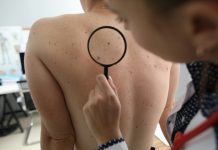
Skin cancer is the most common type of cancer in the United States.
In a new study, researchers found that visibly seeing signs of skin cancer on the body can strongly motivate people to take actions to protect their skins or to visit their doctors.
This may be the most effective way to make people talk to doctors about skin cancer.
The research was conducted by A group of professors from BYU and the University of Utah.
In the study, the team examined a group of more than 2,200 adults ages 18-89 from across the country.
They tested a variety of methods including showing people facts, stock photos of other people in the sun, photos where moles have been removed, etc.
In total, they used 60 different ways to figure out what method was the most effective.
They found that visual stimulation had a big impact on those whom they studied.
On the surface, many people may not see signs of skin cancer but with the VISIA UV camera system, UV photographs can show existing skin damage caused by UV light exposure which is normally invisible to the naked eye.
The team found UV skin damage photos can cause viewers to feel fear, which then made these people more likely to participate in sun-safe behaviors such as wearing sunscreen or protective clothing.
It also showed that ‘just talking about skin cancer, being inundated with facts and mortality rates” were not as effective as visual signs of skin damage.
The researchers suggest that the UV photos are the most effective in terms of influencing people to change their behavior.
They are the types of images doctors need to use to convince people to screen themselves for cancer.
The researchers hope their finding can help protect more people from skin cancer.
One author of the study is Kevin John, an assistant professor in BYU’s School of Communications.
The study is published in the Journal of Behavioral Medicine.
Copyright © 2019 Knowridge Science Report. All rights reserved.



